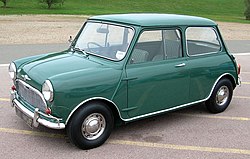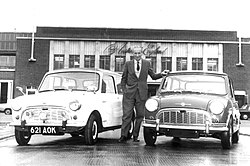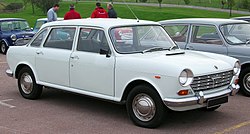世紀汽車 (COTC) 是一項國際獎項,旨在表彰 20 世紀全球最具影響力的汽車。 [1] 評選過程由全球汽車選舉基金會監督。 [2] 獲獎車型是福特 T 型車,於 1999 年 12 月 18 日在美國內華達州拉斯維加斯舉行的頒獎晚會上宣布。 [3]
第一名:福特T型車
第二名:迷你
第三名:雪鐵龍 DS
第四名:福斯甲蟲
第五名:保時捷911
https://en.wikipedia.org/wiki/Alec_Issigonis
亞歷山大·阿諾德·康斯坦丁·伊西戈尼斯爵士(希臘語:Ερνολντ Κωνσταντίνος Iσηγόνης) CBE FRS RDI(1906 年 11 月 18 日至 1988 年 10 月 2 日)是英國希臘汽車設計師。他設計了英國汽車公司於 1959 年推出的 Mini,並於 1999 年被選為 20 世紀第二大最具影響力的汽車。 [1][2]
The Car of the Century (COTC) is an international award that was given to the world's most influential car of the 20th century.[1] The election process was overseen by the Global Automotive Elections Foundation.[2] The winner, the Ford Model T, was announced at an awards gala on December 18, 1999 in Las Vegas, Nevada, US.[3]
 1st place: Ford Model T
1st place: Ford Model T 2nd place: Mini
2nd place: Mini 3rd place: Citroën DS
3rd place: Citroën DS 4th place: Volkswagen Beetle
4th place: Volkswagen Beetle 5th place: Porsche 911
5th place: Porsche 911Alec Issigonis | |
|---|---|
 | |
| Born | Alexander Arnold Constantine Issigonis 18 November 1906 |
| Died | 2 October 1988 (aged 81) Edgbaston, Birmingham, England |
| Nationality | British-Greek |
| Occupation(s) | Automotive designer and engineer |
| Known for | Designer of the Morris Minor, Austin Mini, and the Mini Moke |
| Honours | Knight Bachelor Commander of the British Empire Fellow of the Royal Society Royal Designer for Industry |
Sir Alexander Arnold Constantine Issigonis (Greek: Αλέξανδρος Άρνολντ Κωνσταντίνος Ισηγόνης) CBE FRS RDI (18 November 1906 – 2 October 1988) was a British-Greek automotive designer. He designed the Mini, launched by the British Motor Corporation in 1959, and voted the second most influential car of the 20th century in 1999.[1][2]
Early life and education









Issigonis was born on 18 November 1906 in the Ottoman port city of Smyrna, the only child of Constantine Issigonis and Hulda Prokopp.[3] His paternal grandfather, Demosthenis, had migrated to Smyrna from the Greek island of Paros in the 1830s and Constantine was a successful and wealthy shipbuilding engineer.[4] His maternal ancestors originated in the Kingdom of Württemberg. It was through his mother's kinships that Issigonis was a first cousin once removed to BMW and Volkswagen director Bernd Pischetsrieder.[5]
As British subjects, his father having naturalised whilst studying engineering in London in 1897, Issigonis and his parents were evacuated to Malta by the Royal Navy in September 1922 ahead of the Great Fire of Smyrna and the Turkish capture of Smyrna at the end of the Greco-Turkish War.[3][6][7] His father died shortly after and Issigonis and his mother moved to the United Kingdom in 1923. Issigonis studied engineering at Battersea Polytechnic in London. Having failed his mathematics exams three times, subsequently declaring it 'the most uncreative subject you can study',[3] Issigonis decided to enter the University of London External Programme to complete his university education.
Career
Despite the political upheavals the Issigonis family lived an affluent and comfortable life. Issigonis was maintained by his family so that he could pursue racing sport as a hobby.[8] Issigonis went into the motor industry as an engineer and designer working for Humber Limited. He competed successfully in motor racing during the 1930s and 1940s. Starting around 1930, he raced a supercharged "Ulster" Austin Seven, later fitting it with a front axle of his own design, leading to employment at Austin. This greatly modified machine was replaced with a radical special completed in 1939, constructed of plywood laminated in aluminium sheeting. The suspension was also of advanced design, with trailing arm front suspension attached to a steel cross-member, and swing axle rear, all with rubber springs made of catapult elastic. This car was remarkably light, weighing 587 lb, of which the engine contributed 252 lb. By the time the chassis had been completed (hard labour; it was all done by hand, no power tools), Issigonis had moved to Morris Motors Limited, but Austin supplied a "works" specification supercharged side-valve engine. Issigonis usually won, even when entered in the 1100cc class if there was no 750cc category. Most events entered were sprints, but he also raced at circuits.
Morris Motors
In 1936 Issigonis was given the opportunity to work for a leading motor manufacturer as suspension designer. Morris Motors was based in Cowley near Oxford.[9] Issigonis worked on an independent front suspension system for the Morris 10. The war prevented this design from going into production but it was later used on the MG Y-type. He worked on various projects for Morris through the war and towards its end started work on an advanced post war car codenamed Mosquito that became the Morris Minor, which was produced from 1948 until 1971.
Alvis Cars
In 1952, just as the British Motor Corporation (BMC) was formed by the merger of Morris and Austin, he moved to Alvis Cars where he designed an advanced saloon with all-aluminium V-8 engine, and experimented with interconnected independent suspension systems. This prototype was never manufactured because its cost was beyond Alvis's resources.
BMC
At the end of 1955, Issigonis was recruited back into BMC, this time into the Austin plant at Longbridge, by its chairman Sir Leonard Lord, to design a new model family of three cars. The XC (experimental car) code names assigned for the new cars were XC/9001, for a large comfortable car, XC/9002, for a medium-sized family car, and XC/9003, for a small town car. During 1956 Issigonis concentrated on the larger two cars, producing several prototypes for testing.
The Mini
However, at the end of 1956, following fuel rationing brought about by the Suez Crisis, Issigonis was ordered by Lord to bring the smaller car, XC/9003, to production as quickly as possible. By early 1957, prototypes were running, and by mid-1957 the project was given an official drawing office project number (ADO15) so that the thousands of drawings required for production could be produced. In August 1959 the car was launched as the Morris Mini Minor and the Austin Seven, which soon became known as the Austin Mini. In later years, the car would become known simply as the Mini. Due to time pressures, the interconnected suspension system that Issigonis had planned for the car was replaced by an equally novel, but cruder, rubber cone system designed by Alex Moulton. The Mini went on to become the best selling British car in history with a production run of 5.3 million cars. BMC and Issigonis were awarded the Dewar Trophy by the Royal Automobile Club (RAC) for the innovative design and production of the Mini.[10] This ground-breaking design, with its front wheel drive, transverse engine, sump gearbox, 10-inch wheels, and phenomenal space efficiency, was still being manufactured in 2000 and has been the inspiration for almost all small front-wheel drive cars produced since the early 1960s.
In 1961, with the Mini gaining popularity, Issigonis was promoted to Technical Director of BMC. He continued to be responsible for his original XC projects. XC/9002 became ADO16 and was launched as the Morris 1100 with the Hydrolastic interconnected suspension system in August 1962. XC/9001
https://en.wikipedia.org/wiki/Alec_Issigonis
Sir Alexander Arnold Constantine Issigonis (Greek: Αλέξανδρος Άρνολντ Κωνσταντίνος Ισηγόνης) CBE FRS RDI (18 November 1906 – 2 October 1988) was a British-Greek automotive designer. He designed the Mini, launched by the British Motor Corporation in 1959, and voted the second most influential car of the 20th century in 1999.[1][2]

沒有留言:
張貼留言